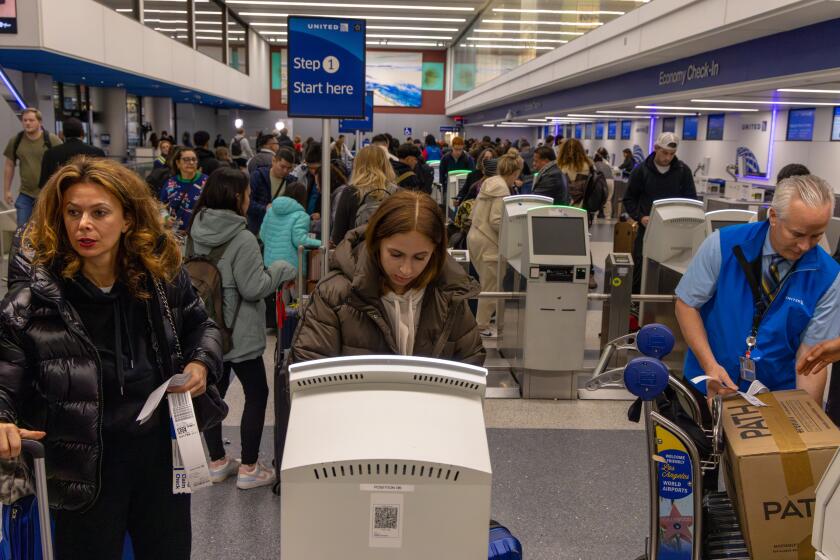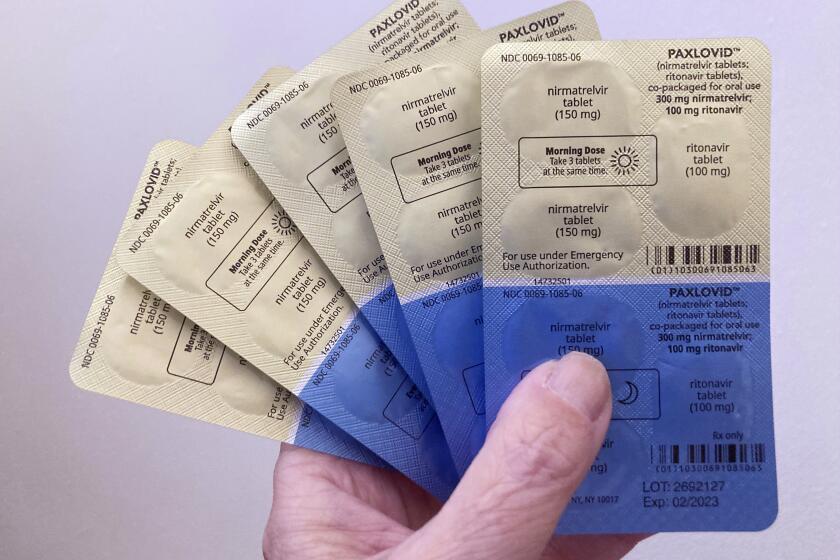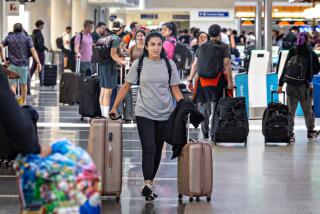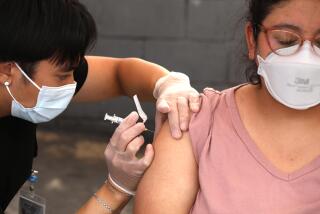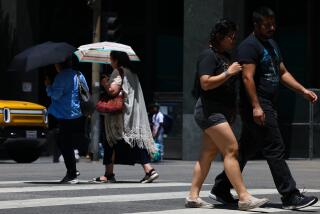California relaxes COVID isolation guidance. What you need to know
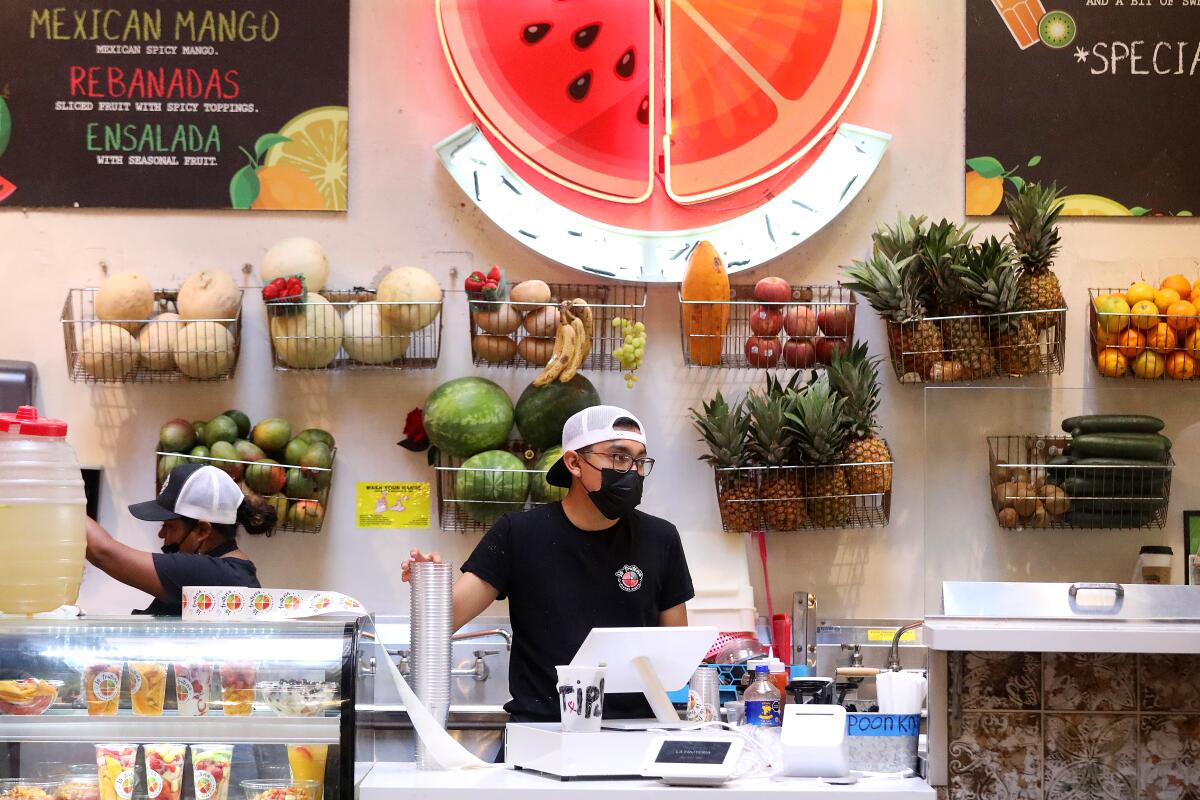
- Share via
With COVID-19 no longer the widespread public health emergency it was in years past, public health officials at both the state and Los Angeles County levels have relaxed their guidance on how long individuals need to isolate from others after they are infected.
Both agencies note that earlier guidelines were implemented to reduce the spread of the coronavirus. But most policies are now focused on protecting those most at risk for serious illness while reducing social disruption.
Here’s what you need to know about the new guidelines:
How long do I have to stay home?
Under guidelines revised this month, officials at the California and county departments of public health now say those who test positive need to isolate and stay home only while they have active COVID-19 symptoms. Those who test positive but remain asymptomatic need not do so.
Those who do develop symptoms — such as a cough or body aches — can end their isolation period once their symptoms are mild and improving, provided they haven’t had a fever for 24 hours without using medication.
L.A. County health officials strongly recommend that infected people get a negative rapid test result if they want to leave isolation within 10 days following the onset of COVID-19 symptoms or their first positive test, if asymptomatic. A negative test is not needed on or after the 11th day.
Earlier guidance stated that those who were infected should stay home for at least five days.
The uptick in illness, documented through wastewater surveillance, coincides with a sharp rise in flu activity during what’s proving to be a busy season for respiratory viruses.
“Previous isolation recommendations were implemented to reduce the spread of a virus to which the population had little immunity and had led to large numbers of hospitalizations and deaths that overwhelmed our healthcare systems during the pandemic,” the California Department of Public Health said in a statement.
“We are now at a different point in time with reduced impacts from COVID-19 compared to prior years, due to broad immunity from vaccination and/or natural infection and readily available treatments for infected people.”
The U.S. Centers for Disease Control and Prevention, which most recently updated its guidance last spring, still recommends isolating for at least five days after the beginning of symptoms or your first positive test if you have no symptoms.
Regardless of symptoms or isolation, health experts recommend that anyone who has COVID-19 stay away from those at higher risk for severe illness for 10 days.
Coronavirus transmission is once again spiking in California entering the winter holiday season — and the new JN.1 subvariant may be partly to blame.
What about masking?
Officials say those with COVID-19 need to wear a well-fitting, high-quality mask around others for 10 days after the onset of symptoms or, if asymptomatic, after they first test positive.
Infected people can stop masking sooner if they test negative on two consecutive rapid tests taken at least one day apart.
Should I seek medication?
Anyone who has COVID-19 should speak with a healthcare provider as soon as possible to learn whether they may be eligible for treatment, such as a prescription for Paxlovid or other antiviral medication.
Health officials have warned that health providers are prescribing Paxlovid and other antiviral medications at lower rates than they should be. “Antivirals are underused. ... Don’t wait for symptoms to worsen,” the CDC said in a statement Thursday.
A common reason why healthcare providers decide against prescribing antivirals is the fear of “Paxlovid rebound,” in which an infected person initially feels better after taking the medication, only for COVID-19 symptoms to recur, forcing them to restart their isolation period.
In fact, scientists have noted that rebound can happen regardless of whether someone takes Paxlovid.
According to a study published by the CDC in December, “Rebound should not deter providers from prescribing lifesaving antiviral treatments when indicated to prevent morbidity and mortality from COVID-19.”
Americans have embraced the idea that Paxlovid is to blame for COVID-19 relapses in people who’ve seemingly recovered. Scientists aren’t so sure.
When should I test?
The CDC recommends testing immediately if you have COVID-19 symptoms, and experts note a positive result from an at-home rapid test is usually reliable.
But a negative result, especially from a test taken early on, may not be as accurate, as it can take a few days for the virus to reproduce in quantities high enough to be detected.
If you test negative, but have COVID symptoms, the CDC suggests retesting after 48 hours. And during that period, officials say you should stay home and away from other people or mask up if you need to be around others.
But even if you test negative on a second at-home test, try for a third in another 48 hours — or four days after the onset of symptoms, the CDC says.
Doctors say this guidance is important, as some people are testing positive later. Some experts think the lag is a result of people having accumulated immunity from COVID-19 over the years, whether from vaccinations or previous infections.
At-home rapid COVID-19 tests generally detect a coronavirus infection at least 80% of the time, according to the Food and Drug Administration. They are most likely to show up positive when coronavirus levels in someone’s nose are high.
The delay in accurate test results is probably a result of people having accumulated immunity from COVID-19 over the years, whether from vaccinations or previous infections.
What should I do if I’m exposed to COVID-19?
Everyone exposed — regardless of whether they have symptoms — should mask up right away, and continue to do so through the end of the 10th day after exposure.
Those who have symptoms should test immediately and stay home.
Those with no symptoms should test within three to five days of their last date of exposure. (Close contacts who were previously infected with COVID-19 in the last month don’t need to test unless symptoms develop.)
What are ways to avoid COVID-19 transmission in a household?
If possible, coronavirus-positive people should stay in a separate room, away from those who are not infected.
“Bring as much fresh air into your home as possible. Open windows (if it is safe to do so) and use fans to blow air out or use air purifiers,” the L.A. County Department of Public Health recommends. “Use a separate bathroom or, if sharing a bathroom, clean and disinfect touched surfaces after each use.”
People should wash hands often with soap and water for at least 20 seconds, and clean and disinfect “high-touch” surfaces routinely, at least once a day.
Ron DeSantis cited a scientific journal as evidence Florida had a lower COVID death rate than California. The study’s author says that’s not the whole story.
How can I get a COVID test or antiviral medication?
The U.S. government is allowing residents to order free at-home COVID tests through COVID.gov. People are able to order four free at-home tests per household. And if they didn’t already place an order between Sept. 25 and Nov. 19, they’re eligible for two separate orders of four tests.
In general, doctors and health plans remain responsible for providing free COVID tests to patients, according to the L.A. County Department of Public Health.
In California, state law still requires most health plans — those regulated by the state — to reimburse for the cost of eight at-home test kits per month. But residents should check the details with their health plan and see whether they need to purchase through an in-network provider to get fully reimbursed.
There may be some Medicare patients who don’t qualify for free at-home tests. However, COVID-19 testing is free if ordered by a doctor. And some with Medicare Advantage plans may still be eligible for free at-home tests.
Free tests are available in a number of settings in L.A. County, including at libraries, senior centers and food banks. More information can be found at ph.lacounty.gov/COVIDtests or by calling (833) 540-0473. Residents can call the same number to seek anti-COVID medication, as well.
The CDC has set up a website, testinglocator.cdc.gov, that displays sites that offer free COVID-19 tests for uninsured people who are ill or have been exposed to the virus.
A program funded by the National Institutes of Health, featured at test2treat.org, gives adults who test positive for COVID-19 or flu free access to telehealth care and treatment. That program is expected to run through early summer. Adults who aren’t positive can still enroll to get free tests shipped to them if they are uninsured or underinsured, on Medicare or Medi-Cal, or in the healthcare system of the Department of Veterans Affairs or the Indian Health Service.
Californians who don’t have insurance or have a hard time getting anti-COVID-19 medication can get a free COVID-19 telehealth appointment until February by calling (833) 686-5051 or visiting sesamecare.com/covidca to request an appointment. Medication costs may be subject to a copay, or might be free, depending on your insurance.
More to Read
Sign up for Essential California
The most important California stories and recommendations in your inbox every morning.
You may occasionally receive promotional content from the Los Angeles Times.

